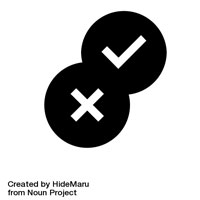
If you’ve been in a forms studio with me, you’ll be familiar with the moment where I say: “No yes/no”.
It’s my shorthand for “Avoid questions that only have two available answers: ‘yes’ and ‘no’. People often struggle with them”.
And here’s the longer version. I’m going to use ( ) as a text shorthand for a radio button answer on a form.
The real world often has more options than two
The world is analog and yes/no is a binary choice, so the two options rarely reflect the real world entirely accurately.
I first encountered this problem myself way back in 2001 when I was testing an online sign-up form for the Open University, the UK’s largest distance learning university. We were using a quiet corner in a large library and intercepting people who could spare us 15 minutes to try out a form.
One person was working happily through when he stopped, bewildered. The question that stumped him was:
“Are you a continuing Open University student?
( ) Yes
( ) No”
I asked him: “What’s the problem?”
He said: “Well, I studied with the Open University back in 1972 when it started, but I had to stop a couple of years later. I’m not continuing, am I? Or am I? I don’t know”.
I knew the answer, which is that once you’ve studied with the university then you count as continuing, no matter how long the gap. But the point was: he didn’t know, and he was stumped.
Once my eyes were opened to the perils of the yes/no question, I found them everywhere. “Do you have an account?” – maybe, I don’t remember. “Interested in our zipzwangle option?” – don’t know yet, what’s a zipswangle?
I constantly see yes/no questions in live forms, and in forms studios, and there are almost always other answers, such as:
- not sure
- don’t know
- neither
- both
- sometimes one, sometimes the other
- don’t understand the question
- this app / organisation / business / corporation / government department doesn’t understand my situation, get me out of here!
I’m not actually expecting you to provide a radio button with that rather long last answer against it, but that’s what many people will think when presented with only two answer options where neither of them works for them.
Spell out the meaning of ‘yes’ and of ‘no’
If you’re considering a question with the two answer options ‘Yes’ and ‘No’, always start prototyping with (as a minimum) the options with what ‘Yes’ means and what ‘No’ means spelled out explicitly, as in:
( ) Yes, I’m going to use a yes/no question
( ) No, I’ll avoid them
Sometimes when you do that spelling out thing, you’ll discover that you can drop the initial Yes or No from the answers:
( ) I’m going to use a yes/no question
( ) I’ll avoid them
Sometimes it’s not at all clear what to add to explain what Yes means and what No means. If this happens, go back and rewrite the question from scratch.
When you test the question with users, they may complain that the parts from the comma onwards are unnecessary. If that’s a consistent result from user research, then it’s fine by me to revert to plain Yes on its own and plain No. Your results from your actual users are always more important than my suggestions. (But note: this has never happened to me in user research).
Prototype with an extra answer
Always test your yes/no questions with at least one extra answer, such as:
( ) Yes, I promise to do that
( ) Maybe I will avoid them
( ) No, I’m going to persist with yes/no
Choose the wording for your extra answer carefully
I often describe the extra answer as the ‘other’ option, and often the word ‘other’ works quite well, such as:
( ) Yes, this is the first option
( ) No, this is the opposite
( ) Other
But be extremely careful that you are not accidentally putting a whole category of people into the ‘other’ category. Think about what being classified as ‘other’ might feel like to the person who is answering. Some wordings for that extra answer can be:
- Not sure
- Not yet
- Maybe
- Sometimes
- Don’t know
And it can be worthwhile asking the person to write in their own answer, perhaps by using one of these introductory phrases with an open textbox for them to type into.
- I’ll provide my own answer
- Something else
- Other, which is:
If nobody ever chooses the extra answer, it’s OK to remove it
In your user research, you may find that nobody ever chooses the extra answer. Don’t remove it at this stage. Keep the extra answer, carefully adjusting its wording depending on what you find in user research. Make sure that the third (or extra) options persist at least into beta. If no-one ever uses it in beta, you can think about scrapping it when you go live.
No sticker yet, sorry
One day I’ll make a sticker with ‘no yes/no’. But today is not that day.
